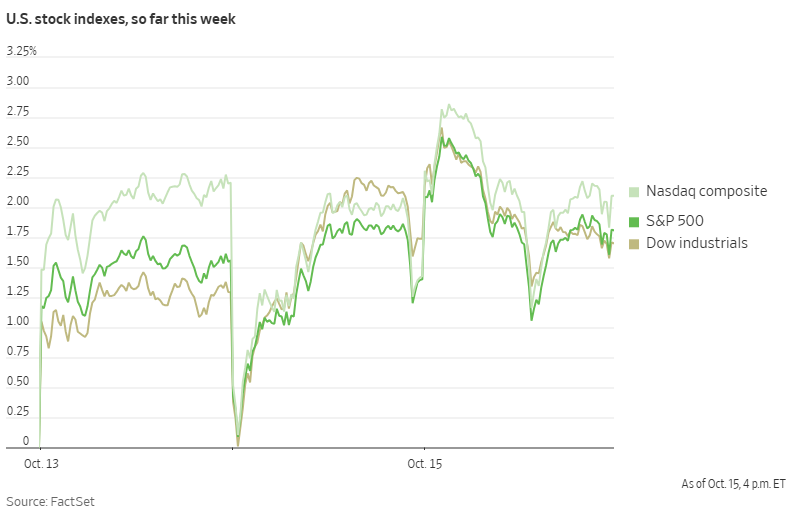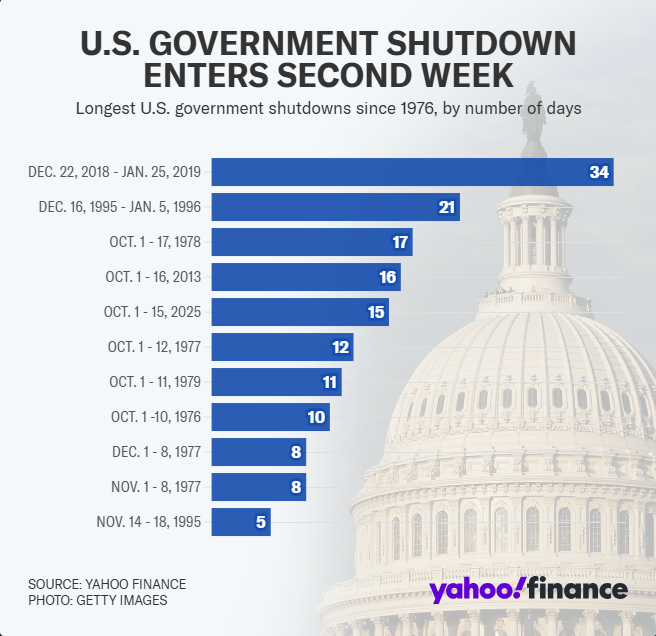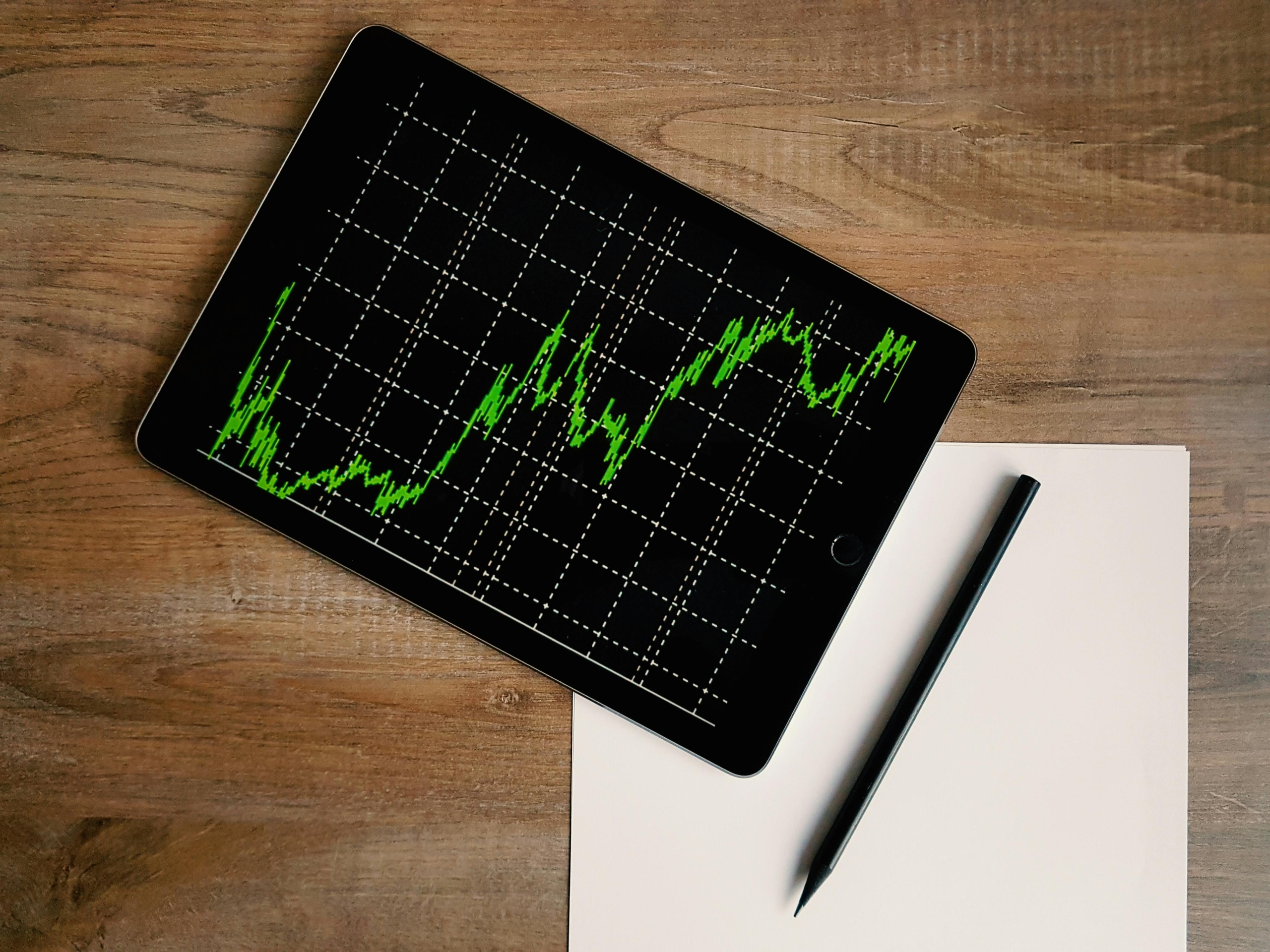市场资讯及洞察

S&P 500 and ASX Rally as Big Banks Drive Markets
Both the S&P 500 and ASX have rallied on the back of stronger-than-expected major bank earnings reports on both sides of the Pacific.
In the US, Bank of America reported a 31% year-over-year increase in earnings per share at $1.06, exceeding Wall Street's estimate of $0.95. Meanwhile, Morgan Stanley delivered a record-breaking quarter with EPS of $2.80, a nearly 49% increase from the same period last year.

On the Australian front, the benchmark ASX 200 leapt 1.03% to 8990.99, with all four major Australian banks playing a major role. CBA closed 1.45% higher, Westpac 1.98%, NAB 1.87%, and ANZ 0.53%.
These strong bank results indicate broader economic strength, despite recent concerns about US-China trade tensions. US Treasury Secretary Scott Bessent emphasised that Washington did not want to escalate trade conflict with China and noted that President Trump is ready to meet Chinese President Xi Jinping in South Korea later this month.
With the third-quarter earnings season just getting underway, these early positive results from financial institutions could prove as the start of continued market strength through to the end of the year.
U.S. Government Shutdown Likely to Last Into November
Washington remains gridlocked as the U.S. enters its 16th day of shutdown. With no signs of compromise on the horizon, it appears increasingly likely the shutdown will extend into November and could even compromise the Thanksgiving holiday season.
Treasury Secretary Scott Bessent has warned "we are starting to cut into muscle here" and estimated "the shutdown may start costing the US economy up to $15 billion a day."
The core issue driving the shutdown is healthcare policy, specifically the expiring Affordable Care Act subsidies. Democrats are demanding these subsidies be extended, while Republicans argue this issue can be addressed separately from government funding.
The Trump administration has taken steps to blunt some of the shutdown's immediate impact, including reallocating funds to pay active-duty soldiers this week and infusing $300 million into food aid programs.
However, House Speaker Mike Johnson has emphasised these are merely "temporary fixes" that likely cannot be repeated at the end of October when the next round of military paychecks is scheduled.

By the end of this week, this shutdown will become the third-longest in U.S. history. If it continues into November 4th, it will surpass the 34-day shutdown of 2018-2019 to become the longest government shutdown ever recorded.
This prolonged shutdown adds another layer of volatility to markets. While previous shutdowns have typically had limited long-term market impacts, the unprecedented length and timing of this closure, combined with its expanding economic toll, warrant closer attention as we move toward November.
Trump Announces Modi Has Agreed to Stop Buying Russian Oil
Yesterday, Trump announced that Indian Prime Minister Narendra Modi has agreed to stop purchasing Russian oil. He stated that Modi assured him India would halt Russian oil imports "within a short period of time," describing it as "a big step" in efforts to isolate Moscow economically.
The announcement comes after months of trade tensions between the US and India. In August, Trump imposed 50% tariffs on Indian exports to the US, doubling previous rates and specifically citing India's Russian oil purchases as a driving factor.

India has been one of Russia's top oil customers alongside China in recent years. Both countries have taken advantage of discounted Russian oil prices since the start of the Ukraine invasion.
Analysis suggests India saved between $2.5 billion to $12.6 billion since 2022 by purchasing discounted Russian crude compared to other sources, helping support its growing economy of 1.4 billion people.
Trump suggested that India's move would help accelerate the end of the Ukraine war, stating: "If India doesn't buy oil, it makes it much easier." He also mentioned his intention to convince China to follow suit: "Now I've got to get China to do the same thing."
The Indian embassy in Washington has not yet confirmed Modi's commitment. Markets will be closely watching for official statements from India and monitoring oil trading patterns in the coming weeks to assess the potential impact on global energy flows and prices.
Chart of the Day - Gold futures CFD (XAUUSD)


Fear of Missing Out (FOMO) is a powerful psychological force that can completely derail your trading potential. It can alter meticulously planned trading decisions, right at the time you’re meant to execute.Having spent many years as a trading coach, FOMO is something I have seen far too often. It masquerades as an urgency to be “in the market” or a stated belief by traders claiming to “feel the market.” Unless you take a step back and honestly evaluate your market behaviour, FOMO can drive you into poorly-timed entries, premature exits, and revenge trades that send your account balance into an ever-decreasing spiral.
What Is FOMO in Trading?
FOMO is the emotional pressure that arises from the belief that you are about to miss out on a profitable opportunity. It is the belief that valid opportunities are few and far between, and if you miss out, it matters.This leads traders to ignore their rigorously tested strategies in favour of emotional reactions. The result is that their trades lack any sort of edge, are poorly timed, and carry too much risk.Many traders report feelings of regret, anxiety, and even shame after making FOMO trades. Over time, this can erode self-confidence and lead to even more impulsive behaviour, creating a negative feedback loop and compounding losses.
Why Does FOMO Happen?
Humans are hard-wired to follow the crowd. When you see traders posting big wins or hear about others catching great trades, your brain sees their success and equates this with missed opportunity.This social comparison triggers an immediate emotional response that can override rational decision-making. People never post their losses or the full context behind their winning trades, so you are only seeing a carefully curated highlight reel that creates a distorted view of success.Recency bias is another major factor in FOMO trading. The tendency to place too much importance on recent events, for instance, if a setup worked extremely well yesterday, you may irrationally believe it will work again today, even if conditions have changed.Recency bias and a scarcity mindset also fuel FOMO trading by making us overvalue recent wins and fear missed opportunities. When yesterday's setup delivered profits, we chase similar patterns today, regardless of changed market conditions. And the belief that profitable setups are rare leads to "itchy trigger finger syndrome" — forced entries driven by the fear that this moment might be our only chance.
How FOMO Shows Up in Trading
Chasing Breakouts
Seeing a strong price move and entering deep into a move (often near the top) is common FOMO behaviour. The trader convinces themselves that it’s better to get in late than miss out entirely, rather than simply accepting to leave it and wait for the next set-up opportunity. This mindset often leads to buying into exhaustion, right before the market reverses.
Overleveraging
The feeling of needing to "make up" for missed trades can cause traders to increase position size on the subsequent trades. While this may lead to larger gains on rare occasions, the fact that the mind is in this “revenge” state can lead to increased use of leverage and worse decision-making, significantly increasing the risk of major losses.
Ignoring Plans
When emotion takes over, traders often abandon their entry criteria, position sizing rules, trade confirmation filters and exit management. The result is a strategy that lacks consistency or any statistical edge from careful creation and evaluation over time of that plan.
Impulse News Trading
Another form of FOMO is jumping into trades during high-impact news events without a planned strategy. The fear of missing out on this visibly happening, large and fast move overrides the caution needed to trade volatile conditions.
Ignoring Take-Profit Targets
Even with predefined profit levels, traders may stay in trades longer, thinking the move potentially “has more legs”. This results in giving back unrealised gains, as rather than pushing further in your desired direction, it reverses and moves back from where it came.
Cancelling Trailing Stops
Traders second-guess trailing stops and move them further away, afraid of being stopped out too soon due to perceived market noise. This leads to worse exits than you may have had should you have left your trail stop as it was.
Holding Through Clear Reversal Signs
Emotional attachment to profit potential causes traders to ignore signals that a trend is reversing, hoping the price will resume its direction. Traders may convince themselves this is merely a retracement, ignoring other signs that a reversal is in progress, e.g. increased volume.
Skipping Partial Closes
FOMO can cause traders to avoid scaling out again despite the pre-trade plan of taking some of the table at specified points. This greed-based decision often results in missing the chance to lock in solid profits. We recently posted an article on mastering partial close that dives deeper into the topic.
How to Manage FOMO
The starting point of managing any psychological challenge in your trading, including FOMO, is to take ownership of it. This means acknowledging that FOMO is your responsibility. Accepting that FOMO impulses originate from within and are entirely under your control is the first step to moving from a reactive approach to a strategic one.Once you’ve come to terms with this, there are several structural and psychological tools and tactics you can employ to avoid future FOMO decisions:
- Realign with your Trading Plans: Every trade should have a specific setup, entry condition, risk limit, and exit plan. Relying on predefined rules helps remove emotional interference. Do a comparison of results when your plan was followed versus when it was not. The chance is that the difference will be obvious and add to the belief that your plan is what you MUST execute under all circumstances
- Controlled Position Sizing: Set out-of-trade limits and always adhere to them when tempted to take any trade. Know that you can ultimately scale, but only on a history of positive outcomes and in a measured way.
- Strategies to trade multiple market conditions: Missing out on a trade will seem less acute if you have a strategy to trade a breakout. Knowing you can bank profit now and simply re-enter a new trade when a break is confirmed is logically preferable to a cross your fingers approach.
- Scaling Out Plans: Having a structured scale-out process helps lock in gains and reduces the temptation to hold everything. Use previous trades and do a “what-if” analysis on a partial close to help build the conviction.
- Increase Journaling: Document details about your trades, including why you took them and how you felt before, during, and after. Pay attention to trades driven by urgency or impulse.
- 10-Second Rule: When you feel the urge to take or alter a trade, pause for ten seconds. Ask yourself: “Is this aligned with my plan or driven by FOMO?”
- Pre-Market Routines: Build routines to get into a focused, rational state before trading begins. Again, we recently published an article on pre-market preparation that may be worth a look.
SummaryFOMO may be a regular part of the human condition, but in trading, it can become one of the most dangerous emotional pitfalls. Without vigilance, it can creep into your trading without you realising. You do not need to catch every trade to be successful, another opportunity will be along soon. You should trade with consistency, discipline, and clarity. Mastering FOMO is not about removing emotion, but having the confidence to follow your strategy, not your fear.


背景2025年5月,美国参议院通过了《GENIUS法案》,标志着美国在稳定币监管方面迈出了关键一步。法案核心内容包括所有受监管的美元稳定币必须以现金、受保银行存款或短期美国国债形式全额储备支持。受美国监管的稳定币中市值最大是USDC,其发行公司Circle在昨晚完成上市,股价被定在31,上市首日即暴涨超168%。何为稳定币?稳定币就是一种“不会乱涨乱跌的数字货币”,它的价格通常固定在1美元左右,让你在使用比特币、以太坊这些“跳来跳去”的币时,有一个稳定的“中转站”或“数字现金”。举个例子,你在币圈里炒币,手里有比特币,就像你手里拿着“股票”,涨涨跌跌。但你不想冒险了,就把币换成稳定币,这就像你把股票变成现金装回钱包里,不会再跌。稳定币市场份额截至目前,稳定币市场总市值已超过2,460亿美元,占整个加密货币市场的约7.5%。其中USDT市场份额61.2%,作为最早的稳定币,在全球范围内被广泛接受,尤其在亚洲市场。USDC市场份额24.8%,在美国监管下运营,透明度高,受到机构投资者的青睐。DAI市场份额3.2%,是去中心化的稳定币,主要通过加密资产超额抵押生成。增长趋势:2025年初至今,稳定币市场增长了近170亿美元,显示出持续的增长势头。USDC增长迅速,市场份额不断增加,正在缩小与稳定币一哥USDT的差距。下面我们介绍其发行公司——Circle。认识CircleCircle成立于2013年,总部位于美国波士顿。最广为人知的产品就是USDC。商业模式:收入结构:高度依赖储备利息收入(99%),2024年总收入16.76亿美元成本结构:与Coinbase的分成协议导致分销成本占储备收入61%盈利表现:2024年净利润1.56亿美元,首次连续两年盈利Circle的护城河:Circle 发行的 USDC 是全球第二大美元稳定币被很多企业和机构信任。就像你出国旅游,用的不是某小国的代币,而是“正经美元”。Circle 让你在区块链上拿的是“正牌数字美元”。Circle 将USDC的储备大部分放在现金和短期美债中,由美国最大资产管理公司 BlackRock(贝莱德)协助管理。Circle的广告词就是“贝莱德帮我管钱,美国政府看着办事”。Circle 是少数能直接参与美国稳定币立法听证会、与国会和财政部沟通的加密企业。在别人还翻围墙找银行开户的时候,Circle 已经在国会喝咖啡和参议员聊政策了。可见Circle的护城河坚固无比,其不是一个普通的加密货币公司,而是全球数字金融基础设施的建设者。它通过USDC为全球提供可信、可审计、可编程的数字美元,让区块链不再只是炒币的工具,而是一个可以承载商业、支付与信用的全球金融网络。总结虽然USDC目前仍是稳定币老二,但是老大USDT不受政府官方承认,USDC凭借“贝莱德帮我管钱,美政府看着做事,国会喝咖啡”的优势正在飞速赶超一哥。尽管上市首日已暴涨168%,在USDC赶超一哥的过程中,Circle市值也将节节攀升,不出政策性意外公司前景还是稳定向好的。需要注意的是Circle的护城河是政府赋予的,股价可能受稳定币法案的变动而波动。联系方式:墨尔本 03 8658 0603悉尼 02 9188 0418中国地区(中文) 400 120 8537中国地区(英文) +248 4 671 903作者:Mill Li | GO Markets 墨尔本中文部


6月初公布的美国“小非农”数据令人意外:5月ADP就业人数仅新增37,000人,不仅远低于前值60,000人,更远逊于市场预期的110,000人。这一数据创下2023年3月以来的最低增幅,也标志着美国产业用工需求正在显著降温。这一指标很有可能带动市场做出反应,比如美元回落、黄金拉升,美债收益率下挫,美股震荡再反弹等等。但这并不只是一次简单的短线波动,更可能预示着美国经济进入“减速换挡”新阶段。一、就业数据滑坡:一次偶然?还是结构性转折?ADP全国就业报告由自动数据处理公司(ADP)发布,作为非农数据的“前瞻指标”,历来具有较强参考性。此次仅新增3.7万人,远低于2024年全年月均14.8万人的水平。分行业来看:- 服务业新增就业仅约26,000人,其中教育与医疗岗位基本持平;- 制造业与建筑业就业人数双双萎缩;- 科技与金融行业招聘全面收缩,显示高息环境对资本密集型企业施压加剧。ADP首席经济学家Nela Richardson指出:“年初招聘热潮正在退却。企业正变得谨慎,尤其是在利率高企与全球需求放缓的背景下。”从领先指标角度看,这种就业收缩不是孤立事件。我们注意到:- 美国ISM制造业指数连续两个月低于荣枯线(<50),反映制造部门整体收缩;- 职位空缺率(JOLTS)自年初高点持续回落;- 消费者信心指数(U.Mich)下行,显示居民对经济前景产生担忧。这暗示美国经济或已进入“滞涨边缘”:增长放缓初现、通胀尚未完全受控,经济动能正在减弱。二、对资产价格的启示:美元、黄金的跷跷板1. 美元:高位承压,结构性见顶?自进入2025年开始,美元的强势地位已经开始松动。走出了一路下行的趋势,在昨日ADP数据公布后,特朗普更是喊话鲍威尔说需要立刻马上降息,也体现出目前美元正在面临严峻考验:实质利差优势减少;欧洲央行与加拿大央行已开启降息周期,形成“美元独强”的套利压力;全球资金配置趋向平衡,美债吸引力下降。这些种种因素都让市场判断在未来中短期美元可能会依旧保持这种承压状态。2. 黄金:避险与政策博弈的受益者金价在ADP数据公布后也呈现出小幅上拉趋势,短期内可能依旧保留冲击3400平台的实力。若本周五非农进一步低于预期,金价有望挑战前高。目前黄金走势依旧强劲主要推动因素还是美元的走弱,和美国目前公布的数据都开始显现出经济增速放缓趋势。三、后市展望:美国进入“衰退缓冲区”?从ADP数据出发,我们可以作出以下判断:- 经济阶段: 当前处于增长动能放缓期,类似2019年Q3或2007年Q1的“滞胀预演”;- 政策路径: 若6月非农和CPI双双低于预期,美联储有望在9月降息25bp,年内或总计两次;- 市场资产轮动: 风险资产短期震荡,资金向黄金、债券、部分防御板块(消费、公用事业)集中。ADP的疲软只是第一块多米诺骨牌。接下来的6月非农、CPI、PPI、ISM服务业指数将共同构成市场对“经济是否拐头”的判断依据。当下投资者需要放下短期情绪波动的干扰,关注背后真正重要的变量:美国经济是否正在从高利率中“失速”?政策窗口是否已打开?现在手上持有的资产组合是否能够应对接下来的经济阶段。联系方式:墨尔本 03 8658 0603悉尼 02 9188 0418中国地区(中文) 400 120 8537中国地区(英文) +248 4 671 903作者:Yoyo Ma | GO Markets 墨尔本中文部


Introduction: The Moment Before the MoveThere is one key habit that appears to separate consistent high-performance traders from the rest, i.e. they fully prepare before engaging in the “battle of the market”.Before a position is amended or a new order is placed, professional traders engage in a ritual or daily agenda (as many of you have heard me discuss on webinar sessions). This is a structured, repeatable pre-market process that puts YOU in the best place to maintain consistency with your trading plan in the context of current market conditions. Arguably, this should be part of your overall trading system or trading business plan.The Daily Market Prep Checklist, which you can download by clicking the button below, has been designed with exactly this in mind, to help traders like you start every trading day fully in tune with both the market environment and your internal trading state.Whether or not you want to take advantage of the free download, this article aims to not only explain each part of the checklist but also explain what to do and why it could be important in your decision-making process.Whether an experienced trader or less so, additional tips have been added so you can move towards fine-tuning your edge or looking to move to the next level.Click Here to Download your Free ChecklistReading the Market's MoodYour first task in your trading day is to understand the current market context.Looking at what happened overnight that may continue to shape the day ahead is vital, not only simply skimming headlines passively, but to actively engage with the flow of global financial information and current drivers. You are trying to build a picture of not only what has happened but what may happen next.This helps in assessing the day’s potential market bias, such as whether it is a bullish, bearish, or range-bound environment, there is generally a risk-on or risk-off narrative and what the flow is in and out of the major asset classes. Additionally, of course, an evaluation of volatility may help inform not only general risk but also how you may approach some of the positioning you may consider, e.g. where to place stops and take profits, as well as position sizing.What matters is that you are asking the right questions to help you form a strategy for the market NOW before you act. It is not about getting things right all the time; this is an unrealistic goal, but surely a considered opinion and approach of where the risks and opportunities may be is far better than going in “blind”.Pro Tip: Market bias is often seen with a review of major global futures; these are the gauges of sentiment. Their pre-market and movement can add weight to your overall market view.Intermediate Trader Tip: Observe whether volatility expectations (e.g., VIX or price action on longer timeframes) are aligning with any technical setups you may be seeing.Risk Framework and PositioningBefore you even open your trading platform, your approach to risk should already be mapped out. How many trades are you willing to have open today, and how much of your account are you prepared to risk per position are ESSENTIAL questions to answer at the start of a trading session.This step is not about limitation. It’s about removing decision fatigue and emotional interference once the market opens, particularly in the event of rapid and significant market moves across multiple positions at the same time. For example, knowing that you’ll only open a maximum of two trades today forces you to be selective and choose those with the strongest set-ups. In addition, “market-oriented” position sizing is a logical way to manage the emotional difficulties of increased account risk due to challenging markets.The Economic Calendar Moves PriceTraders often focus on the technical picture seen on a chart and miss the ticking countdown to scheduled economic events that may move prices in seconds. Whether a central bank decision, CPI data, if there is a significant move away from numbers that were expected, the market doesn’t just respond tamely, but may undergo a major recalibration.Of course, this is not only important in terms of opening new positions but managing the open trades you already have, and you are faced with three choices pre-data release:
- To ride it out
- To tighten trail stops/reduce positions
- Exit positions
Taking a few minutes each morning to scan for high and medium-impact events and making the decision on what action you will take and when will serve you well when attempting to manage risk more effectively in these situations.Intermediate Trader Tip: Start logging how your watchlist instruments react to specific events over time. Journal your chosen approach versus the alternatives to inform you in the future.The Key Levels That Matter: The current price is always interacting with the overall structure of price over time. This reality and a key part of your preparation is about identifying those price points where action is most likely to occur and sentiment changes become apparent. These might be recent highs and lows, clear support or resistance zones and of course, round numbers.Again being prepared through identifying these, particularly those which are approaching such important key price levels can be difference of you getting in or out of a trade at the optimum time as sentiment changes (or doesn’t change suggesting a trend move may be completed), rather than missing an opportunity to get in at the start of a move (rather than later) or taking profit rather than giving it back to the market.Pro Tip: Print your charts with levels marked or take a screenshot each morning. Reviewing these in hindsight builds your pattern recognition and potentially assists in the creation of EAs or informing strategy changes.Beyond the Charts – Knowing Market DriversNot every market move is tied to a pre-defined data release. Often, as we have seen many times of late, unscheduled events can be massively impactful on sentiment. Geopolitical tensions that may escalate, trade talks that may influence industries in the back of a “truth social” post, or policy meetings that may produce outcomes that could shift sentiment, e.g. new policy bills, OPEC meetings.If you can identify two to four potential market drivers beyond the usual data points this may be good information to have when creating your market “picture”, and although you may not have to act on these immediately, knowing that they exist puts you in a better position to respond appropriately rather than react emotionally has got to be a good thing,Pro Tip: Ask yourself: If this potential story escalates, which instruments are likely to move, and what does that mean to what I am going to do/not do today?Personal Readiness to tradeThis is the most overlooked and underrated part of pre-market preparation. As traders, we often feel that we “have to trade” rather than assessing the risk that we are bringing to the table if we are not in the optimum trading state (again, a topic covered in previous webinars).Logically, we need to be able to permit ourselves not to trade or to trade less, if we are not in the best place to make decisions at any time or day.Evaluate where you are at the start of the day with your emotional state, potential out-of-market distractions, and physical wellness. Markets and the potential opportunities that they can give will still be there tomorrow. You must be honest with yourself. If today isn’t the right day, you can reduce size, trade less, or don’t trade at all.Pro and Intermediate Trader Tip: Track your psychological state in a journal alongside trade results. Patterns will emerge. You’ll start to see which states lead to your best performance — and which sabotage it.Click Here to Download your Free ChecklistSummary: The Professional Begins Before the BellThis checklist is not just about technical steps; it’s about creating alignment between you and your interaction with the market. Having considered information that will help form your approach for the day, enables consistency in execution, and this will always be served well by consistency in preparation. Whatever and however you are trading, your process logically should be the same in that you need to do the things not just to prepare to trade but to prepare to perform at the next level you can.The real work starts before the market opens.If you have found the article and particularly the download useful, then we would be delighted with any feedback you can give. Please feel free to connect at any time at [email protected] with any thoughts you have about this or other things that may be useful to you on your trading journey.


在使用MT5进行技术分析时,你是否也遇到过这种情况:想快速知道某一段K线之间的波动区间、点数变化或时间跨度,却只能手动一个个数?其实,MT5内置了一个简单但高效的小工具,只需轻轻一点,就能立刻显示两点之间的详细数据。今天就带你解锁这个新手常忽略、高手常用的小技巧,大幅提升你的分析效率!简单一拖,关键数据一目了然。首先,打开MT5交易软件,并选择任意一个品种的K线图。在默认设置下,当我们将鼠标悬停在图表上,想查看某个点的具体位置时,往往只能依靠目测来对齐右侧的纵坐标获取价格数据。这种方式不仅难以精确定位,还容易出现偏差。对于横坐标上的时间信息,同样需要用眼睛去比对时间轴,既不准确,又非常耗时。为了提升图表分析的效率,我们可以启用十字光标功能。你可以通过点击上方工具栏中的十字光标图标来开启,也可以使用快捷键Ctrl+F进行快速切换。

这样通过十字光标的横竖两条直线,我们可以快速定位到鼠标所处位置的时间和价格。如果想要关闭十字光标,只需用鼠标左键点击图表任意位置即可。除了十字光标这个显而易见的功能,MT5中还隐藏着一个非常高效的实用工具——它可以帮助我们快速测量两点之间的距离,并自动计算所选区间内的涨跌幅。具体怎么操作呢?启用十字光标后,先将光标定位在你想查看的起始点,然后按住鼠标左键,拖拽到目标终点。此时,图表上会出现一组数据,展示这两个点之间的统计信息。

例如图中所示:3251.49:终点对应的价格40 bars:起点到终点之间包含的K线数量32335 points:两点之间的价格差,以点为单位+11.04%:该区间内的涨跌幅,正值为上涨,负值为下跌通过这个功能,我们可以在几秒钟内快速查看任意区间的价格变化,显著提升K线图分析的效率。总的来说,MT5中的十字光标不仅能精准定位图表上的价格与时间,更隐藏了一个强大的区间测量功能,让我们可以高效地获取两点之间的K线数量、价格差以及涨跌幅。这一简单操作,大大节省了分析时间,也让图表阅读更加直观。下次在看K线图时,不妨试试这个小技巧,也许你会发现,提升效率,其实就是从这些细节开始的。联系方式:墨尔本 03 8658 0603悉尼 02 9188 0418中国地区(中文) 400 120 8537中国地区(英文) +248 4 671 903作者:Michael Miao | GO Markets 悉尼中文部


刚刚过去的周末,几则重磅消息已为本周市场走势埋下伏笔。从宏观数据到国际政策,再到大宗商品与热门板块,投资者迎来一个“不能忽视”的开局。✅ 核心数据释放积极信号上周五公布的美国核心PCE物价指数如期放缓,前值上修进一步凸显通胀回落的趋势。同时,GDP修正值较初值小幅改善,基本面边际好转,三大股指周线均录得上涨,市场情绪略显回暖。⚠️ 关税摩擦再起波澜周末,美国政府在贸易政策上动作频频。一方面,提高部分钢铁进口关税至50%,引发多方关注;另一方面,贸易代表办公室却延长了部分对华商品的301条款关税豁免至8月底,显示政策内部仍存在一定平衡考量。与此同时,相关关税调整也引发了欧盟与加拿大的回应预期,贸易摩擦有升温迹象。避险情绪随之上升,黄金价格早盘快速拉升。 油市反应反常,OPEC增产未压价格尽管OPEC+宣布小幅增产41.1万桶/日,国际油价却出现逆势上涨,反映出市场对供需结构紧张的持续担忧。在大宗商品价格波动加剧的背景下,通胀路径仍存在不确定性。 非农在即,降息预期再起本周市场将迎来美国非农就业数据。目前预期显示就业增长或显疲态,若数据显著回落,美联储在降息问题上的博弈或再度升温。考虑到前期数据偏强的“修正期”效应,本周将成为政策预期的重要观察窗口。 板块表现:防御属性更受青睐AI及其应用、核电、量子科技等热门题材在上周均有不俗表现。但若美股整体转弱,相关板块可能面临短期回调风险。相对而言,公共事业成为短期防御方向,电力股如杜克能源等或具备一定交易机会。稳定币概念下,CRCL上市预期也值得关注。 澳股及汇市表现:依旧偏弱本周澳股开局可能偏弱,缺乏强劲驱动。汇率方面,澳元早盘小幅走强,澳美短线反弹,但持续性存疑。美元保持稳定,美日小幅震荡,市场整体仍以稳为主。 数字市场方面比特币维持在10.5万美元附近小幅上行,短线企稳迹象初现,但整体仍缺乏强劲推动力。 小结:PCE回落、GDP好转,提供了温和利好;但关税升级、就业隐忧与油价反弹又使得市场信心承压。在多空博弈加剧的背景下,美股本周大概率维持震荡整理格局,结构性防御配置建议优先考虑公共事业类资产。保持谨慎,静待非农落地,是本周应对波动的不二之选。联系方式:墨尔本 03 8658 0603悉尼 02 9188 0418中国地区(中文) 400 120 8537中国地区(英文) +248 4 671 903作者:Xavier Zhang | GO Markets 高级分析师

